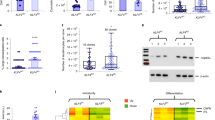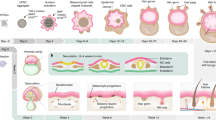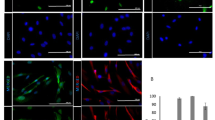Abstract
In this study, we describe a simple system in which human keratinocytes can be redirected to an alternative differentiation pathway. We transiently transfected freshly isolated human skin keratinocytes with the single transcription factor OCT4. Within 2 days these cells displayed expression of endogenous embryonic genes and showed reduced genomic methylation. More importantly, these cells could be specifically converted into neuronal and contractile mesenchymal cell types. Redirected differentiation was confirmed by expression of neuronal and mesenchymal cell mRNA and protein, and through a functional assay in which the newly differentiated mesenchymal cells contracted collagen gels as efficiently as authentic myofibroblasts. Thus, to generate patient-specific cells for therapeutic purposes, it may not be necessary to completely reprogram somatic cells into induced pluripotent stem cells before altering their differentiation and grafting them into new tissues.
This is a preview of subscription content, access via your institution
Access options
Subscribe to this journal
Receive 12 print issues and online access
$259.00 per year
only $21.58 per issue
Buy this article
- Purchase on Springer Link
- Instant access to full article PDF
Prices may be subject to local taxes which are calculated during checkout







Similar content being viewed by others
References
Takahashi K, Yamanaka S . Induction of pluripotent stem cells from mouse embryonic and adult fibroblast cultures by defined factors. Cell 2006; 126: 663–676.
Zhao R, Daley GQ . From fibroblasts to iPS cells: induced pluripotency by defined factors. J Cell Biochem 2008; 105: 949–955.
Yamanaka S . Induction of pluripotent stem cells from mouse fibroblasts by four transcription factors. Cell Prolif 2008; 41 (Suppl 1): 51–56.
Hanna J, Wernig M, Markoulaki S, Sun C-W, Meissner A, Cassady JP et al. Treatment of sickle cell anemia mouse model with iPS cells generated from autologous skin. Science 2007; 318: 1920–1923.
Park I-H, Zhao R, West JA, Yabuuchi A, Huo H, Ince TA et al. Reprogramming of human somatic cells to pluripotency with defined factors. Nature 2008; 451: 141–146.
Okita K, Ichisaka T, Yamanaka S . Generation of germline-competent induced pluripotent stem cells. Nature 2007; 448: 313–317.
Amabile G, Meissner A . Induced pluripotent stem cells: current progress and potential for regenerative medicine. Trends Mol Med 2009; 15: 59–68.
Okita K, Hong H, Takahashi K, Yamanaka S . Generation of mouse-induced pluripotent stem cells with plasmid vectors. Nat Protoc 2010; 5: 418–428.
Aasen T, Raya A, Barrero MJ, Garreta E, Consiglio A, Gonzalez F et al. Efficient and rapid generation of induced pluripotent stem cells from human keratinocytes. Nat Biotech 2008; 26: 1276–1284.
Liang L, Bickenbach JR . Somatic epidermal stem cells can produce multiple cell lineages during development. Stem Cells 2002; 20: 21–31.
Schnerch A, Cerdan C, Bhatia M . Distinguishing between mouse and human pluripotent stem cell regulation: the best laid plans of mice and men. Stem Cells 2010; 28: 419–430.
Deng J, Shoemaker R, Xie B, Gore A, LeProust EM, Antosiewicz-Bourget J et al. Targeted bisulfite sequencing reveals changes in DNA methylation associated with nuclear reprogramming. Nat Biotechnol 2009; 27: 353–360.
Takahashi K, Tanabe K, Ohnuki M, Narita M, Ichisaka T, Tomoda K et al. Induction of pluripotent stem cells from adult human fibroblasts by defined factors. Cell 2007; 131: 834–835.
Grinnell KL, Yang B, Eckert RL, Bickenbach JR . De-differentiation of mouse interfollicular keratinocytes by the embryonic transcription factor Oct-4. J Invest Dermatol 2007; 127: 372–380.
Chambers SM, Fasano CA, Papapetrou EP, Tomishima M, Sadelain M, Studer L . Highly efficient neural conversion of human ES and iPS cells by dual inhibition of SMAD signaling. Nat Biotechnol 2009; 27: 275–280.
Hennings H, Michael D, Cheng C, Steinert P, Holbrook K, Yuspa SH . Calcium regulation of growth and differentiation in mouse epidermal cells in culture. Cell 1980; 19: 245–254.
Ross JJ, Hong Z, Willenbring B, Zeng L, Isenberg B, Lee EH et al. Cytokine-induced differentiation of multipotent adult progenitor cells into functional smooth muscle cells. J Clin Invest 2006; 116: 3139–3149.
Lau HK . Regulation of proteolytic enzymes and inhibitors in two smooth muscle cell phenotypes. Cardiovasc Res 1999; 43: 1049–1059.
Scholer H, Ruppert S, Suzuki N, Chowdhury K, Gruss P . New type of POU domain in germ line-specific protein Oct-4. Nature 1990; 344: 435–439.
Scholer HR, Dressler GR, Balling R, Rohdewohld H, Gruss P . Oct-4: a germline-specific transcription factor mapping to the mouse t-complex. EMBO J 1990; 9: 2185–2195.
Ovitt C, Scholer H . The molecular biology of Oct-4 in the early mouse embryo. Mol Hum Reprod 1998; 4: 1021–1031.
Avilion AA, Nicolis SK, Pevny LH, Perez L, Vivian N, Lovell-Badge R . Multipotent cell lineages in early mouse development depend on SOX2 function. Genes Dev 2003; 17: 126–140.
Mitsui K, Tokuzawa Y, Itoh H, Segawa K, Murakami M, Takahashi K et al. The homeoprotein Nanog is required for maintenance of pluripotency in mouse epiblast and ES cells. Cell 2003; 13: 631–642.
Kuroda T, Tada M, Kubota H, Kimura H, Hatano SY, Suemori H et al. Octamer and Sox elements are required for transcriptional cis regulation of Nanog gene expression. Mol Cell Biol 2005; 25: 2475–2485.
Rodda D, Chew J, Lim L, Loh Y, Wang B, Ng H et al. Transcriptional regulation of nanog by OCT4 and SOX2. J Biol Chem 2005; 280: 24731–24737.
Varas F, Stadtfeld M, de Andres-Aguayo L, Maherali N, di Tullio A, Pantano L et al. Fibroblast-derived induced pluripotent stem cells show no common retroviral vector insertions. Stem Cells 2009; 27: 300–306.
Sommer CA, Stadtfeld M, Murphy GJ, Hochedlinger K, Kotton DN, Mostoslavsky G . Induced pluripotent stem cell generation using a single lentiviral stem cell cassette. Stem Cells 2009; 27: 543–549.
Yusa K, Rad R, Takeda J, Bradley A . Generation of transgene-free induced pluripotent mouse stem cells by the piggyBac transposon. Nat Methods 2009; 6: 363–369.
Stadtfeld M, Nagaya M, Utikal J, Weir G, Hochedlinger K . Induced pluripotent stem cells generated without viral integration. Science 2008; 322: 945–949.
Wong CJ, Casper RF, Rogers IM . Epigenetic changes to human umbilical cord blood cells cultured with three proteins indicate partial reprogramming to a pluripotent state. Exp Cell Res 2010; 316: 927–939.
Halprin KM . Epidermal ‘turnover time’—a re-examination. Br J Dermatol 1972; 86: 14–19.
Webb A, Kaur P . Epidermal stem cells. Front Biosci 2006; 11: 1031–1041.
Jiang Y, Henderson D, Blackstad M, Chen A, Miller R, Verfaillie C . Neuroectodermal differentiation from mouse multipotent adult progenitor cells. Proc Natl Acad Sci USA 2003; 100: 11854–11860.
Torrado M, Lopez E, Centeno A, Medrano C, Castro-Beiras A, Mikhailov AT . Myocardin mRNA is augmented in the failing myocardium: expression profiling in the porcine model and human dilated cardiomyopathy. J Mol Med 2003; 81: 566–577.
Acknowledgements
We thank the members of the Bickenbach lab for helpful discussion, Matthew Fitzgerald and Dr Frederick Domann for assistance with the bisulfite technique and members of the UI Flow Cytometry Core. This research was funded in part by grants from the National Institutes of Health to JRB (R21AR053936 and R01AR053619) and by a grant from the Maryland Stem Cell Research Fund to RLE and JRB (MSCRFII-0178-01).
Author information
Authors and Affiliations
Corresponding author
Ethics declarations
Competing interests
The authors declare no conflict of interest.
Rights and permissions
About this article
Cite this article
Racila, D., Winter, M., Said, M. et al. Transient expression of OCT4 is sufficient to allow human keratinocytes to change their differentiation pathway. Gene Ther 18, 294–303 (2011). https://doi.org/10.1038/gt.2010.148
Received:
Revised:
Accepted:
Published:
Issue Date:
DOI: https://doi.org/10.1038/gt.2010.148



